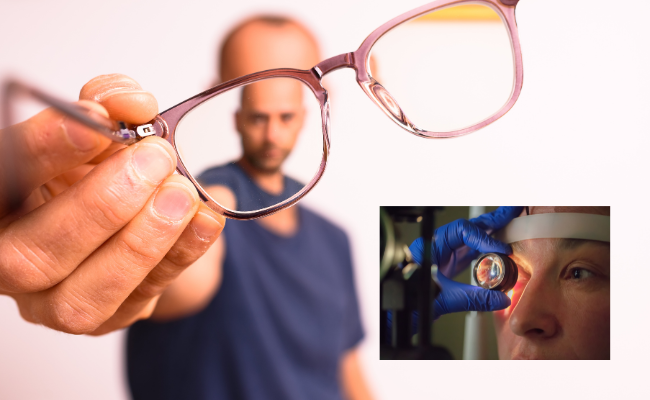How to Treat Astigmatism?
- November 28, 2023
- No Comments

What is Astigmatism?
Astigmatism, a common vision condition, arises when the cornea or lens has an irregular shape, leading to blurred or distorted vision. Unlike normal eyes, which have a round-shaped cornea and lens, astigmatism results in uneven curvature, preventing proper light focus on the retina and causing a refractive error.This irregular curvature characterizes astigmatism as a medical condition, causing a refractive error that often leads to blurred vision. In contrast to the usual round shape resembling a baseball, eyes with astigmatism are more football or spoon-like, causing light to bend unevenly and affect vision at different distances.
Why Does Astigmatism Occur?
Astigmatism can develop for various reasons, and it often occurs alongside other refractive errors such as nearsightedness (myopia) or farsightedness (hyperopia). The primary causes include:
- Irregular Shape of the Cornea or Lens: The cornea and lens should ideally be evenly curved to refract light accurately. When their curvature is uneven, it causes distorted vision.
- Genetic Factors: Astigmatism can run in families, suggesting a genetic predisposition to this vision condition.
- Eye Injury or Surgery: Trauma to the eye or certain eye surgeries can alter the shape of the cornea, leading to astigmatism.
- Keratoconus: This is a progressive condition where the cornea gradually thins and bulges outward, resulting in astigmatism.
How to Identify Astigmatism?
Astigmatism can be diagnosed through a comprehensive eye exam conducted by an optometrist or ophthalmologist. The following diagnostic tools may be employed:
- Visual Acuity Test: This test measures the clarity of vision at various distances, helping to identify the presence of astigmatism.
- Refraction Test: By using a phoropter or an automated instrument, the eye care professional can determine the degree of astigmatism.
- Keratometry: This test measures the curvature of the cornea and is particularly useful in assessing the degree of astigmatism.
- Corneal Topography: This advanced imaging technique provides a detailed map of the cornea's surface, aiding in the diagnosis and treatment planning for astigmatism.
How to Treat Astigmatism?
Several effective treatment options are available to correct astigmatism and improve visual acuity:
- Prescription Eyeglasses: The most common and non-invasive method of correcting astigmatism is through prescription eyeglasses. Specially designed lenses compensate for the irregular curvature of the cornea or lens, allowing light to focus properly on the retina.
- Contact Lenses: Toric contact lenses are specifically designed to address astigmatism. These lenses have different powers in various meridians to correct the uneven curvature of the eye.
- Refractive Surgery: For those seeking a more permanent solution, refractive surgeries like LASIK (Laser-Assisted In Situ Keratomileusis) or PRK (Photorefractive Keratectomy) can be considered. These procedures reshape the cornea to correct refractive errors, including astigmatism.
- Orthokeratology (Ortho-K): This non-surgical option involves using specially designed rigid gas permeable contact lenses overnight to reshape the cornea temporarily. The effect lasts throughout the day, providing clear vision without the need for corrective lenses during waking hours.
- Phakic Intraocular Lenses (IOLs): In cases where refractive surgery is not suitable, implantable lenses can be placed inside the eye to correct astigmatism along with other refractive errors.
Treatment Solutions for Astigmatism
- Eyeglasses: Prescription eyeglasses are a simple and effective solution for astigmatism. The lenses are custom-made to address the specific refractive errors in different meridians of the eye.
- Contact Lenses: Toric contact lenses are available in various types, including soft and rigid gas permeable, providing options for individuals with astigmatism who prefer not to wear eyeglasses.
- Refractive Surgery: LASIK and PRK are popular refractive surgeries that can correct astigmatism by reshaping the cornea. These procedures are quick, and recovery is relatively fast, offering a long-term solution.
- Orthokeratology (Ortho-K): This non-invasive option is suitable for individuals who want to experience clear vision without the need for glasses or contact lenses during the day. Regular follow-ups with an eye care professional are essential to monitor the corneal reshaping.
- Phakic Intraocular Lenses (IOLs): For those ineligible for LASIK or similar surgeries, implantable lenses provide a viable alternative. These lenses are placed in front of the natural lens inside the eye to correct refractive errors.
Benefits of Treating Astigmatism
- Improved Vision: The primary benefit of treating astigmatism is significantly improved vision. Whether through eyeglasses, contact lenses, or surgery, correcting the refractive error enhances the clarity of vision and reduces distortion.
- Enhanced Quality of Life: Clear vision contributes to an improved quality of life by enabling individuals to perform daily tasks with ease and participate in various activities without hindrance.
- Reduced Eye Strain: Astigmatism can cause eye strain and discomfort due to the effort required to focus on objects. Corrective measures alleviate this strain, reducing eye fatigue.
- Increased Safety: Clear vision is crucial for activities such as driving. Treating astigmatism enhances safety by ensuring that individuals can see clearly and react appropriately to their surroundings.
- Long-Term Convenience: While eyeglasses and contact lenses provide effective short-term solutions, refractive surgeries and other corrective measures offer long-term convenience, reducing the dependence on external aids for clear vision.
Comments (0)